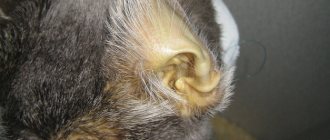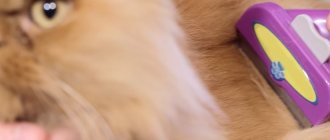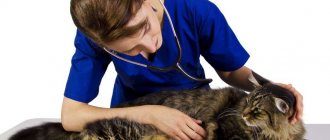Specifics of sounds made by cats
A cat purrs when it feels pleasure and more
Many owners of furry pets have probably wondered why cats purr. In order to communicate with people or other animals, cats use various types of communication. Rumbling is one of them. A pet can show its mood through various gestures, the position and vibration of its tail, and also by making sounds.
First, let's look at what is meant by rumbling.
The rumbling and purring that the mustachioed-striped one makes is accompanied by rhythmic vibration in parts of the animal’s body. This is one of the ways of communication, healing and reassurance, reporting the animal's condition.
Interesting: Only felines can purr.
Why and why do cats purr?
There are several versions of why cats purr:
- Show pleasure . The easiest way to make a cat purr is to pet it. An affectionate animal will definitely thank its owner for his kindness and affection.
- Express satiety . A tasty treat will certainly cause loud purring,
- They remind the owner of themselves. A cat can purr loudly, demanding attention, and also begging for another portion of a tasty delicacy.
- Expression of emotions. Purring is often compared to those situations when people quietly hum something to themselves.
- Health recovery. The vibrations that pass through the animal’s body can stimulate metabolic processes and improve blood circulation. This helps the animal to warm up and calm down, for example, after a strong fright.
- Meeting another animal. By purring, a cat demonstrates its favor towards another individual. Adult and strong males meow loudly and thereby show weaker individuals that they are not going to attack.
- Communication with a cat. Very young kittens begin to purr loudly when close to their mother, as well as during feeding. Representatives of wild breeds use this sound to inform the older individual that everything is fine with them. This is especially important in those moments when an adult animal goes hunting at night.
- Pain relief and recovery from injuries. There is a theory that by purring cats stimulate the brain to produce a special hormone that acts on their body as an analgesic, relaxing and healing agent. There have been many recorded cases of a wounded or sick animal purring.
- Expression of fear. A frightened animal can make loud noises, as if asking not to be offended.
- Preparation for sleep. Purring before bed, the cat calms itself down and sets itself up for a long rest.
- Self-defense. With loud purring, a cat protects its kittens or food. At these moments, it is better not to approach the animal, since it can even attack the owner.
- Manifestation of the hunter's instinct. Sometimes a quiet purr can be heard from an animal that, for example, is watching birds flying nearby.
Cat purring mechanism
The sound of rumbling comes from the cat's larynx
Since humans cannot make purring sounds, like all other animals, the question arises, what do cats purr with? Do they have any special rumbling device for this? It turns out that not everything is so complicated.
The pleasant, soothing, soft sounds of purring occur as a result of the contraction of the throat muscles and the vibration of air inside the larynx, which leads to vibration. The amplitude, tone, and duration of purring may vary in cats, but the vibration frequency is within 20-30 Hz. The rumbling does not stop with inhalation and exhalation, but on the contrary occurs just during breathing.
When a cat purrs, a certain hormone is produced that has a calming function.
Research has also shown that the vibration from the purr strengthens the animal's bones, joints and skeleton due to the vibrations of the air. This is explained by the fact that such a habit could have been developed in the animal due to a sedentary lifestyle and to prevent muscle atrophy.
Interesting: kittens begin to purr when they are a couple of days old.
How do cats purr?
We are able to observe the purring, understand the reasons and reasons for its occurrence. But what can we say about the mechanism for producing these purring sounds? Oddly enough, it has not been fully studied by scientists.
What is clear is that a special organ that would produce such sounds was not found in cats. Otherwise, instead of a clear answer, we are offered a number of scientifically based assumptions/theories:
- The purring is caused by the vibration of the cat's lungs.
- Occurs when there is a change in blood movement/circulation in the cat’s body.
- In recent studies, the mechanism of purring is described as a sequence: “the appearance of electrical impulses in the cat’s cerebral cortex - the vocal cords receive these impulses - contraction of the muscles associated with them.”
How does the mechanism for producing purring sounds work?
The “purring apparatus” itself is a thinly connected hyoid bone, which is located between the base of the skull and the base of the tongue. But it is the contraction of the muscles near the vocal cords that causes them to vibrate, and, accordingly, the appearance of purring sounds.
At the same time, the cat’s mouth and nose participate in their reproduction, while the vibration spreads throughout its entire body. One of the features of purring is the inability to listen to the cat’s heartbeat and monitor its breathing.
If necessary, to stop the sounds of purring, it is recommended to turn on the water from the tap - while it flows, the cat stops purring.
The main reasons for a cat's purring
A cat purrs when he feels safe, but may also purr to relieve stress or pain.
A cat's purring is never without a reason. Purring expresses their emotional and physical state.
It is generally accepted that cats purr only when they are happy. Surely in most cases it is for this reason.
However, a cat's purring can also be detected when the cat is excited, scared, injured, before giving birth and at other exciting times. Why does she purr when he is stressed? In this way, the animal calms and heals itself.
To better understand the reason for purring, let’s look at the accompanying actions of the animal.
- It stomps its paws on or near a person and purrs. The animal marks its owner in this way, demonstrating its own importance.
- Rumbling when stroking indicates that the cat is receiving true pleasure.
- A loud, restless purr, similar to a tractor, accompanied by accompanying soft and cute movements, may indicate an injury to the animal. It is necessary to pay attention to whether she is experiencing a painful condition, whether she is trying to crawl out of the wound, whether she is experiencing discomfort and other disturbances in her general condition.
- The purr of a mother cat while feeding her cubs calms the babies.
- A cat may also purr after a tasty and satisfying meal and during a nap.
- A cat's purring can also be its anticipation of pleasant moments: treats, emotions, games.
- A caring pet may begin to purr, sensing the painful state of its owner, in an attempt to calm him down.
- A cat purring during a meeting with a veterinarian may indicate that the animal is stressed and trying to calm down.
Cats purr when communicating with their own kind.
In addition, cats also use purring when communicating with their own kind. If a cat purrs when meeting another animal again, this indicates that she is in a friendly mood. The purring of a cat during aggressive play or a fight with another cat is evidence that she is giving up and raising the “white flag”.
Rumbling can also express boredom, or a cat may begin to purr before a serious and responsible action, such as jumping from a high cabinet.
Scientists have not yet figured out the exact reasons for the start of the rumbling mechanism in mustaches.
Interesting: Cats can’t purr in their sleep, but they can easily purr during a nap.
Rumbling is a sign of peace and more
Many of us believe that since a cat purrs, then everything is fine. But, unfortunately, such uterine sounds are not always a sign of pleasure or satiety. Let's see in what cases you can hear a cat purring:
Photo: Maine Coon cat | Dreamstime.com
- Possessive rumbling
- if a cat tramples with its front paws and purrs, then one can suspect that this is how the animal marks the owner in a unique way, making it clear to the person that the head of the house is His Majesty the Cat; - Rumbling as a sign of pleasure from communicating with a person
- almost all cats purr when they are petted, but suddenly stop doing this when they get tired of the owner’s touch; - Purring as an attempt to help oneself
- sometimes a cat purrs like a tractor if something hurts. So, a pet may well purr, licking its wounds after a collision with a neighbor’s dog. A cat can purr during a fracture caused by a fall from a height, during childbirth, or during an exacerbation of any chronic illness. It's sad, but sometimes animals purr even before they die, perhaps trying to calm themselves down; - Rumbling as a signal of calm for kittens
- if you watch a nursing mother and her cubs, you will notice that the cat moves her paws and purrs when the kittens suckle her milk. Rumbling at such moments is necessary for babies to feel safe; - Rumbling as a sign of a peaceful attitude
- sometimes cats can purr in front of each other. They do this in order to demonstrate goodwill to other individuals; - Rumbling as an accompaniment to sweet slumber
- cats cannot purr in their sleep, but during rest and slumber they can purr quite well. Especially in situations where a delicious lunch has been eaten and there is no threat around; - Rumbling as an anticipation of something good
- our pets begin to rumble when they anticipate that something pleasant or tasty is waiting for them. So, a cat can easily start “singing” loudly if he sees that the owner is sitting down in a chair (it’s time not just to watch TV, but also to pet the cat!). Or you can hear the purring of an animal that has seen and felt that the owner has begun to cut up fish or meat in the kitchen; - Rumbling as an attempt to cure the owner
- many owners know that cats can predict a person’s mood, and also feel when a person is not feeling well. For example, if a cat owner has a heartache, then the pet can easily lie down on the cat’s chest and begin to purr and rumble. This is how the animal tries to help the owner cope with pain.
So, there are many reasons for a cat’s purring.
But how can you recognize when an animal makes such sounds from pleasure and when from pain? It turns out that cats always purr in different ways. Thus, a loud rumbling at a frequency of about 50 Hz may indicate that the pussy is trying to cope with the pain of a fracture or dislocation, and a rumbling at a frequency of 100 Hz or more may indicate that the animal is suffering from some kind of chronic disease. In addition, the vigilant owner will be able to notice the state of ill health by other alarming symptoms in addition to loud rumbling: elevated temperature, upset stool, vomiting, limping, and so on. And if an animal purrs quietly at a low frequency of up to 35 Hz, closing its eyes and tucking its paws under itself, then it is probably in calmness and in a good mood.
Why do cats purr near humans?
Cat expresses gratitude and bond with owner
Is the person the owner of the cat or the cat the owner? Everyone thinks differently. If a cat actively presses its paws on the owner's chest and purrs at the same time, this means that it shows him its superiority over him, marking him as his property.
But rumbling towards a person can express gratitude, affection, greeting, recognition, a request for attention or food, or the joy of playing with the owner.
Accompanying purring with active drooling next to a person or on a person speaks of sincere and genuine love and trust in him.
Feeling the sadness and illness of its owner, the cat can also get closer to him and begin to purr. Thus, she wants to restore the mood and condition of her owner, healing him from his illness.
How to determine a cat's desires by purring
Rubbing and purring? She clearly needs something from a person, most likely food or she’s just bored
The timbre, amplitude, and volume of purring reveal different emotions and desires of the animal.
- A loud and worried rumbling indicates pain (injury or illness). It is necessary to observe the animal, establish accompanying symptoms and help it.
- Increased rumbling and active tail wagging indicate the animal's dissatisfaction. If the owner strokes the cat at the same time, it means that these actions must be stopped, she does not like it.
- A nursing cat protects her offspring with a loud purr and signals that no one should approach her or her kittens.
- A soft purr and closed eyes indicate the pleasure the animal receives.
- The cat purrs and rubs against the owner - it requires attention or treats.
Important: a cat can purr before dying.
The effect of a cat's purring on humans
Rubbing and purring? She clearly needs something from a person, most likely food or she’s just bored
Purring not only brings pleasure and relaxation to the cat itself, but also has a beneficial effect on the human condition.
Stroking the animal and feeling the vibrations from the rumbling with your hand helps a person cope with stress, anxiety, relaxes him, and reduces the risk of heart disease.
The sounds and vibrations produced, according to experts, have a positive effect on human health in the following areas:
- For muscle, joint and bone pain.
- With decreased immunity.
- Psychoneurological disorders.
- Diseases of the heart and digestive organs.
- For blood pressure.
- Helps with headaches.
- For respiratory problems.
Purring is not the only source of recovery, but it helps to alleviate the general condition, improve mood and relieve anxiety.
The most purring breeds
Maine Coons are affectionate and loving pets
The breed of the cat does not matter for the animal's purring, nor does age or gender. However, the rumbling depends on the character and disposition of the pet. More affectionate cats purr more often, and touchy-feely cats purr less often.
Some of the most affectionate and purring felines are:
- The Russian Blue cat, which has an open and gentle character, loves to play with children.
- The Sphynx is one of the most responsive breeds, allowing itself to be stroked, sat on your lap and played.
- Siberian and Neva masquerade cats are very affectionate to their owner and are not stingy with warmth, kindness and love. Always ready to help and cheer up with purrs.
- Maine Coons, despite their size and serious appearance, actively demonstrate their love for their owner and are not shy about it.
I also have a gentle disposition in such breeds as Burmese, Abyssinian, exotic and ragdoll cats.
But other cats, depending on their mood, are ready to bestow their relationship with their owner with warmth and a pleasant purr.
Purring as communication
Depending on the timbre and volume, the purring of one cat may indicate a demonstration of a social role in front of another. A quiet purr speaks of friendly and peaceful thoughts: for example, a cat thus shows the cat its defenselessness. Loud is a manifestation of dominance.
Many owners note that if someone in the house is sick, the cat will certainly purr supportively over the sick person.
A person is perceived by a pet as an equal member of the pack. A purring pet shows the household its affection, gratitude, or asks for affection. If a cat with a raised tail purrs loudly and sparkles its eyes at a guest or a new thing, this means a demonstration of hostility.
Interesting facts about rumbling
Cheetahs can purr too
- Not only domestic cats have the purring function, but also such predators as the cheetah, snow leopard, raccoon, puma and jaguar.
- But the tiger and lion can growl more than purr.
- Large ones from the cat family purr when exhaling, which is more like a roar, and small ones both when inhaling and exhaling.
- A cat can purr only with one inhabitant of the house, whom it recognizes as the owner, and react to others with complete silence.
- To stop your cat from purring at the veterinarian's appointment to measure her heartbeat, you need to drown out her purring with the sound of water, and she will become silent.
- Cats purr from birth until death. Before her death, these may be the last sounds she makes. This is how she tries to calm down and ease her anxiety.
- Since kittens are born deaf and blind, the mother cat's purrs help them locate her and feel safe.
- There are services for listening to cat purrs online.
- Purring helps cats recover from injuries, promotes bone healing and strengthens joints.
- Purring before bed helps cats fall asleep.
- During long sleep, rumbling replaces physical exercise for the cat.
- In 2015, the cat Merlin was included in the Guinness Book of Records for the loudest purr of about 68 decibels (average frequency 25 decibels), that is, the noise level between a sewing machine and a hair dryer.
That loud cat Merlin and his owner
Yet, in most cases, with its purring, a cat next to its owner expresses its love, recognition, calmness and trust. A cat, with its purring, will not only thank its owner for his care and kindness, but will also help him cope with fatigue, stress and increase his immunity.
If the cat is happy, the owner is happy too.











